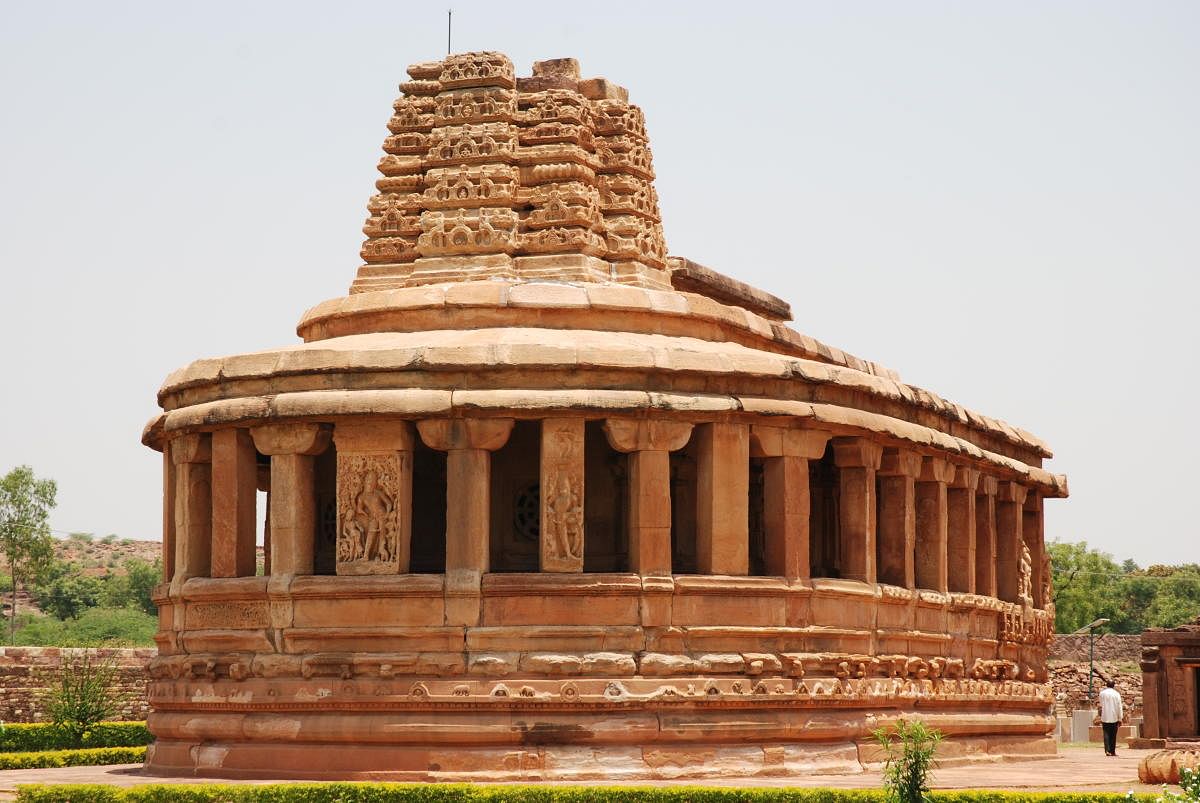
I was on a heritage sojourn to the ‘Golden Triangle’ of North Karnataka covering Badami, Aihole and Pattadakal. After an exploration spree of the monuments in Badami and Pattadakal, I stopped by the tranquil village of Aihole on the banks of River Malaprabha in Bagalkot district. The earliest capital of the early Chalukyan dynasty, Aihole was hailed as the ‘cradle of Indian temple architecture.’ Originally named Aryapura, Aihole was a university town that patronised art, culture and education. The temples are associated with both the early and later Chalukyas,the rulers of Badami. Most of these temples were built between the 6th and 8th centuries and some even in the earlier period.
The best way to explore Aihole is to wander at leisure through the fields and rocky outcrops. As I ambled around the village, I stumbled upon clusters of temples sprinkled in the centre of the village in a fenced enclosure. I found the names of these temples quite intriguing. They do not stand for the main deities of these temples, but represent either the person who lived in them or their location.
Resplendent beauty
The most impressive one in this cluster is the sculpturally resplendent Durga Temple, notable for its semi-circular apse, elevated plinth, basement friezes and a gallery encircling the sanctum. The temple resembling a Buddhist chaitya with a horse-shoe-shaped structure is said to be, the only one of its kind in South India. It was not named after Goddess Durga, but because of its proximity to the fort (durg) wall. I tarried awhile gazing in admiration at its shape, and the carvings of scenes from the Ramayana gracing its walls and ceilings.
The basement friezes have ganas (mythical comical dwarfs), foliage, and full-length niche deities. Among the main figures who appear on the walls are Shiva, Vishnu, Narasimha and Durga. But the carving of the awesome Mahishasuramardini is the most striking, trampling the buffalo demon. There is a small museum behind Durga Temple which houses examples of Chalukyan sculptures.
Lad Khan Temple, which is one of the earliest temples, was the next stop in my itinerary. It was originally a royal assembly hall and marriage mantapa chosen as the abode of a Muslim noble, Lad Khan. River goddesses Ganga and Yamuna, popular icons of the 4th-century Gupta dynasty, flank the entrance. Couples embracing beneath trees are carved on the outer columns of the porch. I did not venture to clamber up the stone ladder leading to the roof shrine with images of Surya, Vishnu and Shiva carved on its walls. Over the cells at the back is a square, flat-roofed superstructure, in effect forming a two-storey sanctum. Two other temples Gaudhar Gudi and Chikki Gudi (both dedicated to Shiva), within the complex, belong to the same age.
After a short stroll through the streets of Aihole, I reached Kunti Group, another interesting ensemble. This quartet of temples, dating from different periods, consists of partly open halls with sloping roofs and overhanging eaves. Each temple has a small sanctuary positioned against the rear wall. The external columns of its mandapa are decorated with erotic couples. The northwest temple also has sculpted figures. The interior is pepped up by three finely carved ceiling panels of Shiva with Parvati, Vishnu on the serpent and Brahma on the lotus. Guardians flank the doorway. The two remaining structures are assigned to the Rashtrakuta era, as is evident from the columns, which have squat proportions and triangular panels of lotus decoration. A free-standing portal with animal brackets links the two north temples.
Elaborately divine
Beyond these temples, further south is Hucchappayya Matha. It has sculptures of amorous couples, while the beams inside are beautifully decorated. The hall is roofed with ceiling panels depicting the same trio of divinities noted in the Kunti Group. Another interesting monument is Ravalaphadi Cave Temple which is Aihole’s only excavated temple. Dating back to the sixth century, Ravalaphadi Cave Temple celebrates the many forms of Shiva and its ceiling is delicately carved with decorative motifs. At the entrance, you’ll be met by life-size sculptures of Ardhanariswara and Harihara. Inside, look for the saptamatrikas (fertility goddesses).
Don’t miss Huchimalli Temple with a sculpture of Vishnu ensconced atop a large cobra. I culminated my trip by clambering up a hill beyond the end of the village on the way to Meguti Temple. This Buddhist Temple has a serene smiling Buddha seated under a Bodhi tree. I was treated to fine views of Aihole and Malaprabha Valley. From the Buddhist Temple, a path leads to Meguti Temple. It is a richly decorated Dravidian temple installed with Lord Mahavira in the lower sanctum. It is known for its inscriptions by the renowned poet Ravikirthi, who built the structure in 634 AD. It has an elevated platform, with two sanctums, a court hall and a portico. The lower sanctum consists of the image of Mahaveera. Compared to the opulence of Hindu temple craft, the Jain and Buddhist temples are spartan.